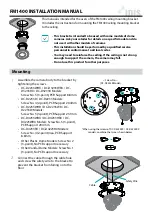
7
Measuring range
Affected angular range and angular steps:
•
With interlaced mode 2x: ± 0.125°
±0,125°
1°
±0
±0,1
,1
,125°
1°
Figure 29: Jittering of the individual measuring points in the affected angular range
•
With interlaced mode 4x: ± 0.0625°
±0,0625°
2°
±0
±0
±0,0
,062
62
625°
5°
2°
2°
2°
Figure 30: Jittering of the individual measuring points in the affected angular range
Formula for calculating the minimum object size in interlaced mode
For calculation of the minimum object size
With interlaced mode 2x: (10.4 + 8.7 + 4.4 mrad / 2) * 16,000 mm + 7 mm = 348 mm
With interlaced mode 4x: (10.4 + 8.7 + 4.4 mrad / 4) * 16,000 mm + 7 mm = 330 mm
3.5.12
RSSI values
RSSI (Received Signal Strength Indicator) is the measure of the signal strength that the
device receives. This value is calculated for every measurement. The device therefore
provides, for every echo signal, an associated RSSI value for the signal strength.
The RSSI values have a resolution of 8 bits with whole-number values between 1 and
255, where 1 represents the weakest signal and 254 the strongest signal (e.g., with a
reflector).
A value of 255 means “dazzled”. The value 0 (zero) means that the received energy
was too low to produce a valid measured value. A valid distance measurement has at
least an RSSI value of 1.
If the RSSI value is 0, then no distance measurement is possible. There can be two
reasons for this:
•
The target object lies outside the sensing range.
•
The target object has an extremely low remission.
Please note that white paper can have very similar values as a reflector at a short
distance.
The RSSI values are sensor-specific, relative values that can vary slightly between
different devices and during the service life of the device.
PRODUCT DESCRIPTION
3
8020494/1AZF/2021-05-10 | SICK
O P E R A T I N G I N S T R U C T I O N S | MRS1000
27
Subject to change without notice
















































